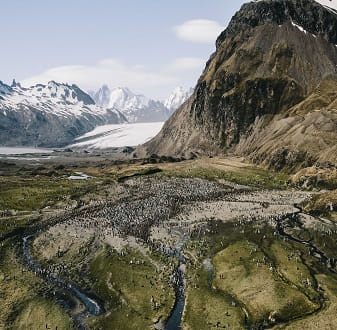Thin Ice VR, the immersive virtual reality experience is produced by Adelaide’s award-winning studio Monkeystack, written and directed by Torrens University Australia lecturer James Calvert, and features modern adventurer and environmental scientist Tim Jarvis AM. The world premiere of Thin Ice VR, an Adelaide Film Festival Investment Fund project, will take place during at Illuminate Adelaide in July in partnership with the Adelaide Film Festival.
The unique production, which has been three years in the making, offers an unrivalled immersive experience, allowing audiences to follow in the footsteps of Tim Jarvis, who recreated Shackleton’s famous expedition which aimed to be the first to cross Antarctica coast-to-coast and became, what is now regarded by many as, the greatest survival journey of all time. It was during this modern-day recreation that Jarvis discovered alarming changes in the region’s landscape – a direct impact of climate change.
Equal parts catastrophic and transcendent, Thin Ice VR presents a unique account of how humanity asserts its will over the extremes of nature -often in unforeseen ways. The intention of Thin Ice VR is to create meaningful awareness of climate change and allow viewers to come to the personal realisation, through the VR experience, that greater and more decisive action needs to be taken.
Director and writer of Thin Ice VR James Calvert, from Torrens University Australia, said the production is as close to an authentic experience as you can get without travelling to the Antarctic.
"Deciding to take on the same challenge that Jarvis did in recreating Shackleton’s adventure may be too much for most people,” said Calvert.
“However, we want audiences to experience Shackleton’s epic story for themselves and learn from his leadership. Thin Ice VR lets us all walk directly in his footsteps. The story extends beyond that of Shackleton’s, to the plight of the greater Antarctic region –a place under threat from climate change. Thin Ice VR gives us all a chance to experience the wonder of this place with our own eyes, where we can see for ourselves the impact of climate change over the last 100 years.”
The Thin Ice VR team, which includes award-winning National Geographic photographer Doug Gimesy, recreated Antarctic locations using photogrammetry - a technique that captures a series of images of a single object or location to create realistic 3D models.
The team also travelled to some of the most remote and hard to reach locations in the Antarctic region to capture the exact locations from Shackleton’s epic journey.
“Combined with the use of volumetric motion capture to add Tim, Shackleton and supporting actors in realistic 3D, we can walk directly in Shackleton’s footsteps, see the wonder of the Antarctic, and witness the impact of climate change of the past century,” said Calvert.
Thin Ice VR Presenter and Executive Producer, Tim Jarvis AM said recreating Shackelton’s journey of survival was a lesson in the determination, optimism and leadership needed to prevail against the odds.
“Thin Ice VR brings his story to life at a time when we urgently need to learn from what he stood for to prevail against the enormous challenges we now face to save our planet,” said Jarvis.
"Shackleton’s goal was to save his men from the ice. Today it is the ice that needs saving from us and the human-induced climate change that threatens it."
Torrens University Australia is proud to be the Major Partner of Thin Ice VR, and the project is also part of Calvert’s research into virtual reality for education. As a Certified B Corporation, Torrens University is driven by the pledge to fundamentally ‘Be Good’ and make a positive impact on society, economy, education and research.
“Thin Ice VR is a ground-breaking project that draws on the university’s investment in design-based research of virtual reality - harnessing the ability to turn images into explorable environments,” said Professor Alwyn Louw, Torrens University Vice-Chancellor.
Thin Ice VR is the second VR project that Calvert has been involved in at Torrens University. In 2017, he was the Project Lead on a VR collaboration between Torrens University and the ABC that immerses school students in the main events of the World War 2 Kokoda track campaign.
Thin Ice VR premieres at Illuminate Adelaide Festival, running from Monday 26 July to Sunday 1 August.
Official website: https://www.thinicevr.com/
About Sir Ernest Shackleton’s expedition to the Antarctic
Sir Ernest Shackleton made his third trip to the Antarctic in 1914 with the ship Endurance, planning to cross Antarctica via the South Pole. The Endurance became trapped in ice early in 1915 and 10 months later, sank. Shackleton and his crew had already abandoned the ship to live on the floating ice. In April 1916, they set off in three small boats, eventually reaching Elephant Island. Shackleton and five of his crew members then went to seek help, spending 16 days crossing more than 1,300 kilometres of ocean to reach South Georgia before trekking over the island’s mountains to a whaling station. The remaining men from the Endurance were rescued in August 1916. Incredibly, no one from Shackleton’s expedition team died.





